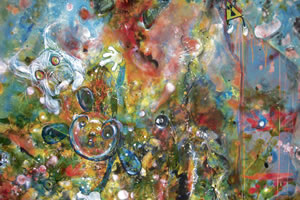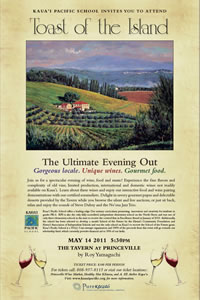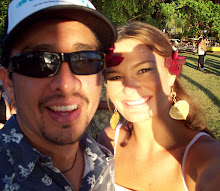By Amanda C. Gregg

Will Lydgate continues his family's tradition of contributing to life on Kaua'i with a residency program for top musicians at his Steelgrass studio, which he's using to promote music education on the Island
Continuing a family legacy of contributing to the good of Kaua’i, Will Lydgate establishes a musical residency program for top music instructors
Will Lydgate is heading off the Island to pursue his calling at Berklee School of Music in Boston. But before leaving, the bass player with deep family roots on Kaua’i made sure he got several projects off the ground, including work on his eco-chocolate farm Steelgrass, bidding aloha to his students at Kaua’i Pacific School, growing his production studio and setting up a residency program for music teachers.
But that’s only part of the well-established resume of the soon-to-be “chowdah head.” Many have likely heard his song Preeta played weekly on KQNG radio. But he also founded the only professional-grade recording studio on Kaua’i, also called Steelgrass. Once a woodshop, the transformed space is now capable of handling everything from voiceover work to cutting an album.
The soundproof digs are just as inspired as they are high end: Floors are covered with exotic rugs, and walls are graced with art from all over the world, and bamboo and grasscloth wallpaper and purple Styrofoam pyramids help tune out everything from feral chickens to trade winds.

Lydgate at his steelgrass studio. Amanda Gregg photos
“Aesthetics are important, as is being inspired,” Lydgate says of the space.
That design made his studio ideal for sound work on films such as Madagascar II and Kung Fu Panda, which meant hosting the likes of Ben Stiller and Jack Black. (He’s also recorded there with ukulele legend Jake Shimabukuro).
Though many likely recognize Lydgate for his name and community work rather than his studio and musical prowess, he is on his way to changing that.
Lydgate’s great-grandfather was Mortimer Lydgate, who first came to Hawaii in April 1865.
“He was a much-beloved community member among all cultures and ethnic groups on the Island,” Lydgate says.
Acquiring property or making money in the sugar industry wasn’t one of his great-grandfather’s priorities (in fact, it wasn’t until the 1990s that his great-grand-father’s descendants were able to purchase the land they now call Steelgrass Farm, as he didn’t believe in land ownership). Yet land is part of how his great-grandfather’s legacy lives on, as Lydgate Beach Park was named in honor of his contributions to the community.
“I feel a special privilege to be part of an old Hawai’i family with deep roots on Kaua’i and on the Big Island,” Lydgate says.
Approximately a year after arriving in Hilo, his great-grandfather gave his first sermon on Kaua’i on the first Sunday in May 1896, and the rest, as they say, is history.

Lydgate has already recorded some big names at his studio
Noting that the best part of the Lydgate family heritage is the public service his great-grandfather set as an example, Lydgate feels honored to follow his great-grandfather’s lead, which not only includes setting aside land for parks and founding the Boy Scouts on Kaua’i, but helping start the public library in Lihu’e and working to spiritually inspire others.
Lydgate will now honor his family’s tradition of helping serve the community in a different way – one that honors music.
“My goal is to get skills and to bring them back here where they can be useful,” he says. “Someday I would love to see a music education center somewhere on the Island – a place for kids to come after school to play contemporary music with skilled instructors. Give the kids something to do that involves their imagination.”
Giving back to the people and the land is in Lydgate’s blood. He’s done everything from co-founding the Kaua’i Agriculture Initiative, an islandwide volunteer program for sustainable agriculture advocacy, to developing initiatives such as the Mayor’s Garden, which grows food for the Kaua’i Independent Food Bank. Lydgate also helped create the Garden Island Range and Food Festival, an annual locovore event that celebrates locally grown and raised food.
Of course, he’s also helped put Steelgrass Farm, a hot spot for eco-tour fanatics, on the map.

Lydgate came by his musical talents from both parents. Damon Moss photo
“Steelgrass Farm has always been in the back of our minds, and I have been groomed to run it for years,” Lydgate says of the property he co-owns with his sister Emily. Lydgate has put his proverbial blood, sweat and tears into the farm, built with the ideology of restoring farm viability to Kaua’i.
Named after bamboo’s nickname, “steelgrass,” the farm grows its own chocolate, boasts hand-pollinated vanilla orchids, cultivates timber bamboo, makes award-winning palm-blossom honey and raises livestock ranging from goats to Araucana hens. It also cultivates something a little more unique than that: music and the arts.
Lydgate formed the Steelgrass Residency program with Berklee School of Music in 2009, which donates housing at Steelgrass Farm for qualified Berklee faculty. The relationship means music teachers can live and board for free on Kaua’i for a week of public performances, master classes and studio recordings. Though Lydgate attended a five-week performance program at Berklee in 2001 and was awarded a D’Addario
Strings Scholarship to attend the school from 2006 to 2007, the residency program has nothing to do with that, or with his return to the college this month. It just happens to be a good program he wants to support.
“There’s no quid pro quo – we just love art,” he says of offering faculty free housing. “There’s no angle.”
The Berklee residency program isn’t the farm’s only philanthropic opportunity, as this year it will begin its Bamboo Sculpture project, a two-week residency for artists to create outdoor bamboo sculpture the last two weeks of August. Selected artists will get to live on the farm during that time and will be given room and board, (as well as bamboo).
It makes sense that the farm would support music and the arts, as Lydgate has been around both most of his life. His dad had a woodshop and played guitar, and his mom played the piano. Lydgate was about 9 when the influence began to take hold.
“Probably in elementary school – I remember when the band teacher brought in the stringed instruments and we got to play them. I was drawn to the cello, which was prophetic because now I am a bass player,” he says, adding that his first official instrument was trombone, and that bass wasn’t something he picked up until age of 14.
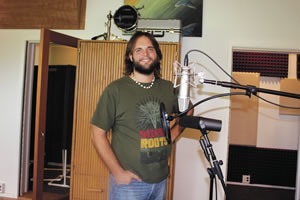
Lydgates’s Steelgrass studio is one of a kind on Kaua‘i. Amanda Greeg photos
Teen-hood for Lydgate also included time at the Peninsula School in California, a sort of organic, progressive school that commends artistic vision, something he continued when he came to Island School as a junior. It was there he met teacher Mary Alfiler (who was the bassist in the rock band Ace of Cups), who allowed him to help teach music to younger students.
It was a natural progression, therefore, for him to pursue music and become a music educator at Kaua’i Pacific School, something he admits he might enjoy even more than his students.
And though it was clear during his last week that those students will miss him, now that Steelgrass Farm is stable enough it’s time for him to return to the Mainland to further his studies.
Of course, he won’t forget the keiki. In fact, it’s with them in mind that Lydgate plans to ensure they, too, get a similar experience to his.
His studies will include work with professors such as Susan Rogers (who engineered Prince’s Purple Rainrecord) and Prince Charles Alexander (whose client list includes The Notorious B.I.G.)
“We are starting a Berklee Hawaii Scholarship fund for Hawaii kids to get help going to Berklee,” Lydgate says. “I hope to see more (local) kids going over there.”
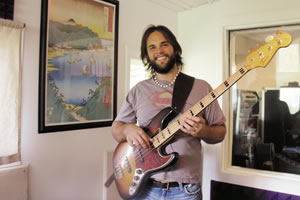
Lydgate will study bass at Berklee
Studying there gave him the taste, to be sure. “It planted the seed of great music education,” he says.
And even though he will be away for a while, Kaua’i will always be home.
“This will always be my home base … I can’t think of a better place to have roots,” he says – an apt metaphor for a musician who will be returning to his farm. “What place can offer the beauty that Kaua’i can?”







